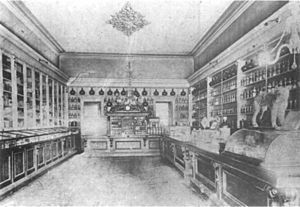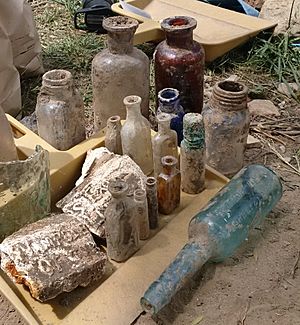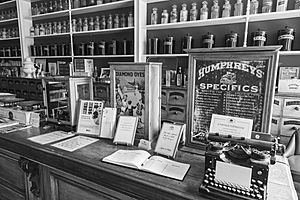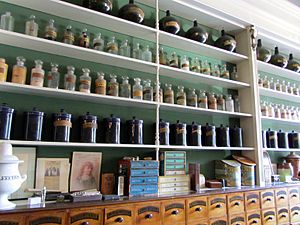Niagara Apothecary facts for kids
Quick facts for kids Niagara Apothecary |
|
|---|---|
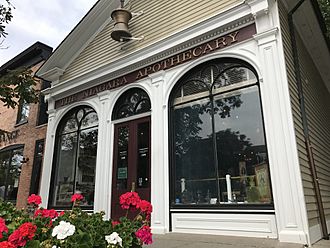
Façade, with a mortar and pestle mounted on the gable
|
|
| Former names | The Niagara Apothecary at the Sign of the Golden Mortar (1818 or later – 1820s) Starkwather and Brown (early 1820s) Niagara Apothecary and Cheap Cash Store (1820s) Niagara Apothecary (1829–1833) Randall's Drug Store (1898–1914) Coyne Drugs (1914–1921) Field's Drugstore (1921–1964) |
| General information | |
| Type | Museum |
| Architectural style | Georgian |
| Address | 5 Queen Street |
| Town or city | Niagara-on-the-Lake, Ontario |
| Country | Canada |
| Coordinates | 43°15′18″N 79°04′15″W / 43.25505°N 79.07089°W |
| Estimated completion | 1818–1820 |
| Renovated | 1970 – 13 May 1971 |
| Renovation cost | $38,000, equivalent to CA$265,000 in 2021 |
| Owner | Ontario Heritage Trust |
| Technical details | |
| Floor count | 1 |
| Renovating team | |
| Architect | Peter John Stokes |
| Official name: Niagara Apothecary National Historic Site of Canada | |
| Designated: | 28 November 1968 |
The Niagara Apothecary is a special place in Niagara-on-the-Lake, Ontario, Canada. It started as a pharmacy, a place where people bought medicines, way back in the 1800s. Today, it's a National Historic Site of Canada and a museum.
This museum shows what a pharmacy looked like during the time of Canadian Confederation (around the 1860s). It's run by the Ontario College of Pharmacy and welcomes about 100,000 visitors every year. It's like stepping back in time to see how medicines were made and sold long ago!
Contents
Saving a Piece of History
Why Preserve Old Buildings?
In the 1960s, people in Ontario started to care more about saving old buildings. They wanted to stop them from being torn down. Niagara-on-the-Lake had many old buildings because it hadn't changed much since the 1800s.
After World War II, new buildings started to appear. So, in 1962, a group called the Niagara Foundation was created. Its goal was to protect the town's history.
Finding the Old Drugstore
The Niagara Foundation asked an architect named Peter John Stokes to look at the town's old buildings. He was an expert in old architecture. He found many interesting places, including Field's Drugstore.
This drugstore had been owned by E.W. Field since 1921. It was special because its inside looked almost the same as it did in the 1860s. The Niagara Foundation worried the store might be sold and changed.
A Partnership to Protect History
In 1963, the Niagara Foundation teamed up with the Ontario College of Pharmacy (OCP). They wanted to save Field's Drugstore and its old items. The OCP thought it would be a great place for a museum about pharmacy history.
When Mr. Field retired in 1964, the partners rented the store. They also got the first chance to buy it. In 1969, the Ontario Heritage Trust (OHF) bought the property. This group works to preserve important historical sites in Ontario.
Bringing the Past to Life: The Restoration Project
In 1962, Peter John Stokes had already noted that Field's Drugstore was very important to the town. He suggested it should be restored if possible. He admired its front, detailed wood carvings, cabinets, and fancy plaster work.
How the Restoration Happened
In April 1970, the OHF and the Canadian government agreed to fund the restoration. It cost about CA$38,000. Peter John Stokes was in charge of the project.
Since there wasn't much written history about the store, Stokes used old photos from 1905. He also looked at the building's original features from the 1970s. The goal was to make the store look exactly as it did in the 1860s.
Workers used old techniques and materials to fix missing parts. They removed anything that didn't fit the historical look, like modern signs. The building was made strong again, and everything was polished or painted.
Opening the Museum
In May 1971, the newly restored museum opened its doors. Pharmacists carefully arranged all the old items. Important people from the government and local community attended the opening. The next day, the Niagara Foundation held a special event for the public.
Who Owned the Pharmacy?
The land where the building stands was given to William Dickson in 1796. The first pharmacy was on a different street, but its owner, Rodman Starkwather, moved it to Queen Street.
In 1833, James Harvey bought the business. He ran it until he passed away in 1851. Many of the glass bottles you see in the museum today are thought to have been brought from England during his time.
Henry Paffard, who used to be Harvey's apprentice, bought the business in 1852. In 1866, a fire damaged his house and the pharmacy. He then bought the current building in 1869. He made big changes, like lowering the floor and adding beautiful black walnut counters.
After 46 years, Paffard sold the business to his apprentice, John DeWolfe Randall, in 1898. Later, Arthur J. Coyne bought it in 1914. He sold it to Erland Field in 1922. Mr. Field ran the store until 1964, when he retired.
The Niagara Foundation bought the property, and then sold it to the Ontario Heritage Foundation in 1969. Today, the Ontario Heritage Trust owns the building. The Ontario College of Pharmacy helps restore and run the museum.
What Was Sold at the Pharmacy?
In the 1800s and early 1900s, rules for pharmacies weren't as strict as they are today. Many different stores sold medicines, and pharmacies sold many other things too!
The Niagara Apothecary sometimes sold gasoline, postal insurance, and even ice cream. They also offered train and boat tickets, and photographic services. From the 1820s to 1840, they even advertised garden seeds!
Records from the Niagara Apothecary show that people bought many kinds of medicines. Some people regularly bought strong medicines. Back then, people often bought medicines without a doctor's prescription.
Inside and Out: The Building's Look
Exterior Design
The Niagara Apothecary is a one-story building made of clapboard wood. It's built in the Georgian style, which was popular long ago. It sits right on Queen Street, which is the main shopping area of the town.
The outside of the building has a mix of styles. It has a fancy entrance, wooden trim, and display windows. These windows are on either side of the main door, with columns in between.
Interior Features
Step inside, and you'll see what a pharmacy looked like during the Confederation era. The counters and cabinets are made of dark wood like black walnut. There's also a beautiful wooden area where medicines were prepared, called a dispensary.
This dispensary has a clock, a carved beaver, and two light globes held by female figures. The windows have Venetian blinds that date back to 1866!
The glass bottles, jars, and pots on the shelves are very old. Many of them were taken by a former owner in 1922. Later, some were bought back and loaned to the museum. Other items came from donations and pharmacy schools.
This building is special because it's the only one in town from the Confederation era that was moved to its current spot in 1866 and still stands today.
A National Historic Site
Recognizing its Importance
The restoration of the Niagara Apothecary is seen as a big success in saving history in Ontario. It was named a National Historic Site of Canada on November 28, 1968. This means it's a place of great importance to Canada's history.
A special plaque was put outside the building. Queen Elizabeth The Queen Mother herself unveiled it on July 5, 1981!
A Unique Museum Experience
An expert named Ernst Stieb said in 1985 that it was "the most authentic restoration of its kind in Canada." The museum is still run by the Ontario College of Pharmacy. About 100,000 people visit it each year.
In 1973, the American Association of State and Local History gave an award to the Ontario Heritage Foundation and the Ontario College of Pharmacy. This was for their amazing work in restoring the apothecary.
The museum focuses on how pharmacy was practiced in the past. It shows the types of materials and tools used. It's a fantastic way to learn about the history of medicine!


